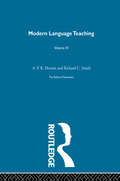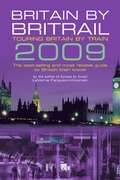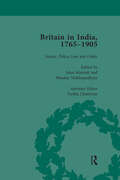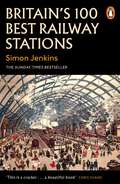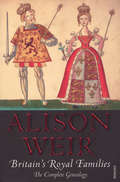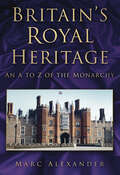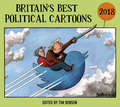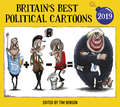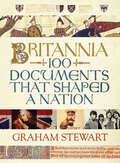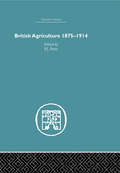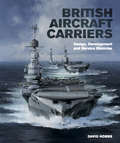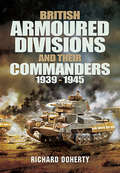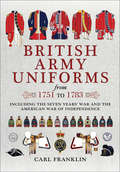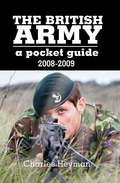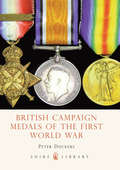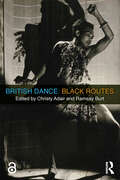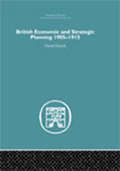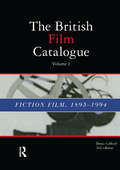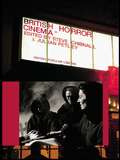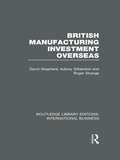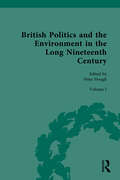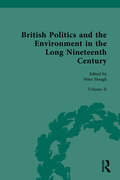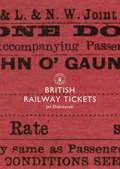- Table View
- List View
Britain and Scandinavia: The Reform Movement (Logos Studies in Language and Linguistics)
by Richard C. Smith A. P. R. HowattThis volume forms part of a five volume set charting the progress of the nineteenth century movement, which was instrumental in establishing international guidelines for the teaching of modern languages. It was during this period that for the first time, co-operation between phoneticians and teachers culminated in the publication of works that were instrumental in establishing the 'applied linguistic' approach to language teaching in the twentieth century. For the first time, too, the new science of psychology influenced a scientific theory of second language acquisition. The Reform Movement attracted support across Europe, spurring the development of new professional associations and journals. In turn, the publication in these journals of reports of innovative practice contributed to a greater sense of autonomy and professionalism among modern language teachers, who had hitherto tended to live under the shadow of classical language teaching. The practical innovations and theoretical suggestions for the foreign language teaching, although rooted in the nineteenth century, still have relevance today.
Britain by Britrail
by Laverne Ferguson-Kosinski Adam PriceFor nearly thirty years, Britain by BritRail has been the best-selling and most respected guide to the British train system. Newly revised and updated, this time-tested and reader-friendly book is packed with all the information you'll need for hassle-free travel. Learn how to use London, Edinburgh, Glasgow, and Cardiff as base cities for more than forty rail trips and day excursions to outlying areas and points of interest in England, Scotland, and Wales--from the medieval city of York, to Dover and its famous cliffs.
Britain in India, 1765-1905, Volume I
by Partha Chatterjee John Marriott Bhaskar MukhopadhyaySeeks to explore the nature of the relationship between Britain and India at the height of imperial expansion. This collection is of interest among academic communities exploring British and Indian history. It is useful for literary, cultural and urban historians working in this area.
Britain's 100 Best Railway Stations
by Simon JenkinsDiscover the architectural gems that are Britain's 100 Best Railway Stations in this Sunday Times top 10 bestseller'This is a cracker . . . a beautiful book' Chris EvansIt is the scene for our hopeful beginnings and our intended ends, and the timeless experiences of coming and going, meeting, greeting and parting. It is an institution with its own rituals and priests, and a long-neglected aspect of Britain's architecture. And yet so little do we look at the railway station.Simon Jenkins has travelled the length and breadth of Great Britain, from Waterloo to Wemyss Bay, Betws-y-Coed to Beverley, to select his hundred best railway stations. Blending his usual insight and authority with his personal reflections and experiences - including his founding the Railway Heritage Trust - the foremost expert on our national heritage deftly reveals the history, geography, design and significance of each of these glories. Beautifully illustrated with colour photographs throughout, this joyous exploration of our social history shows the station's role in the national imagination; champions the engineers, architects and rival companies that made them possible; and tells the story behind the triumphs and follies of these very British creations. These are the marvellous, often undersung places that link our nation, celebrated like never before.'However spectacular the book's photographs, it's the author's prowess as a phrase-maker that keeps you turning the pages' The Times'An uplifting exploration of our social history' Guardian
Britain's Royal Families: The Complete Genealogy
by Alison WeirFascinating and authoritative of Britain's royal families from Henry VIII to Elizabeth I to Queen Victoria, by leading popular historian Alison Weir 'George III is alleged to have married secretly, on 17th April, 1759, a Quakeress called Hannah Lightfoot. If George III did make such a marriage…then his subsequent marriage to Queen Charlotte was bigamous, and every monarch of Britain since has been a usurper, the rightful heirs of George III being his children by Hannah Lightfoot...' Britain's Royal Families provides in one volume, complete genealogical details of all members of the royal houses of England, Scotland and Great Britain - from 800AD to the present. Drawing on countless authorities, both ancient and modern, Alison Weir explores the crown and royal family tree in unprecedented depth and provides a comprehensive guide to the heritage of today's royal family – with fascinating insight and often scandalous secrets.'Staggeringly useful... combines solid information with tantalising appetisers.’ Mail on Sunday
Britain's Royal Heritage: An A to Z of the Monarchy
by Marc AlexanderThis book is more than a biography of kings and queens; it is an encyclopaedic work on every aspect of monarchy in Britain from semi-legendary times to the present day. Arranged in an A-Z format, it includes mini biographies on each of the forty-two kings and queens who have ruled since the Norman Conquest, details of the royal lines in Scotland before the Act of Union, the background to the royal houses of Britain and the consorts – largely foreign – who have married into the monarchy. Royal scandals, wars, ceremonies, households, tombs and insignia make fascinating reading, and this book is the ideal reference work for all those who want to know more about individual monarchs and the impressive legacy of myths, traditions, beliefs and practices that have grown up around the institution of the monarchy.
Britain’s Best Political Cartoons 2018
by Tim Benson____________A blockbuster collection of the year’s funniest political cartoons, featuring the work of Mac, Steve Bell, Peter Brookes and many more . . . 2018 was the year that Brexit got serious, royals got married, football got (briefly) feverish, and Trump got transformed into a giant baby blimp. In Britain’s Best Political Cartoons 2018, our very finest satirists turn their eyes and their pens to all these events and more, offering an incisive and often hilarious tour through a tumultuous twelve months.
Britain’s Best Political Cartoons 2019
by Tim BensonA hilarious companion to the year’s political turmoil, featuring the work of Martin Rowson, Steve Bell, Peter Brookes, Nicola Jennings and many more . . . 2019 was the year of Brexit, obviously. But it was also the year that Donald Trump went haywire over Huawei, Theresa May got bounced by the backstop, Boris Johnson was hoisted into high office, and the country was corralled into a chaotic Christmas election. In Britain’s Best Political Cartoons 2019, our very finest satirists skewer everything from Kremlin collusion to no-deal confusion, offering a riotous ride through the last twelve months. And did we mention Brexit?
Britannia: 100 Documents that Shaped a Nation
by Graham StewartGraham Stewart traces 2,000 years of an island's story—from Roman province to 21st century European nation-state—through 100 historic documentsFrom the eighth-century Lindisfarne Gospels to the great testament of Norman bureaucracy, the Domesday Book, and from the designs for the Union Jack in 1606 to Neville Chamberlain's 1938 Munich agreement with Hitler, the documents selected embrace a wide range of national endeavors: politics and religion, warfare and diplomacy, economics and the law, science and invention, literature and journalism, as well as sport and popular music. The first edition of the Times rubs shoulders with the rules of the newly formed Marylebone Cricket Club; the designs for Stephenson's Rocket with the Catholic Emancipation Act; Lord Kitchener's iconic World War I recruitment poster with Clause Four of the Labor Party's constitution; and the Beatles' Sgt. Pepper album cover with Britain's accession treaty to the European Economic Community. These are documents that not only defined their own eras, but which continue to resonate today.
British Agriculture: 1875-1914 (Economic History Ser.)
by P. J. PerryProfound Changes took place in British Agriculture between 1875 and 1914. After the prosperous years of the mid-nineteenth century came a period of difficulty for landowners and farmers, with falling prices, lower rents and untenanted farms. Previously attributed to bad seasons and increased food imports, this book questions whether the unexpected depression was rather the evolutionary upheaval of a system forced reluctantly into change. Undoubtedly there was a crisis, in these decades farming ceased to be Britain's major industry; no longer able to supply all her own food, the country came to depend increasingly upon imports. Methods changed, cereal production yielding pre-eminence to pastoral farming. In recent years scholars have challenged traditional interpretations of the crisis, seeking a wider range of causes, characteristics and consequences. It has come to be seen as a phenomenon of change as much as of decay. This book brings together different views of the depression, ranging from contemporary evaluations to recent regional and econometric studies which stress its spatial and developmental character. Originally published in 1973, these eight contributions provide a survey of changing approaches to one of the major economic crises in modern history.
British Aircraft Carriers: Design, Development & Service Histories
by David Hobbs&“This superb book . . . will undoubtedly become the definitive volume on British Aircraft carriers and naval aviation . . . magnificent.&”—Marine News This book is a meticulously detailed history of British aircraft-carrying ships from the earliest experimental vessels to the Queen Elizabeth class, currently under construction and the largest ships ever built for the Royal Navy. Individual chapters cover the design and construction of each class, with full technical details, and there are extensive summaries of every ship&’s career. Apart from the obvious large-deck carriers, the book also includes seaplane carriers, escort carriers and MAC ships, the maintenance ships built on carrier hulls, unbuilt projects, and the modern LPH. It concludes with a look at the future of naval aviation, while numerous appendices summarize related subjects like naval aircraft, recognition markings and the circumstances surrounding the loss of every British carrier. As befits such an important reference work, it is heavily illustrated with a magnificent gallery of photos and plans, including the first publication of original plans in full color, one on a magnificent gatefold. Written by the leading historian of British carrier aviation, himself a retired Fleet Air Arm pilot, it displays the authority of a lifetime&’s research combined with a practical understanding of the issues surrounding the design and operation of aircraft carriers. As such British Aircraft Carriers is certain to become the standard work on the subject. &“An outstanding highly informative reference work. It is a masterpiece which should be on every naval person&’s bookshelf. It is a pleasure to read and a pleasure to own.&”—Australian Naval Institute
British Armoured Divisions and Their Commanders, 1939–1945
by Richard DohertyA total of eleven British armoured divisions were formed during the 1939-1945 war but, as this highly informative book reveals, just eight saw action.In 1940 only 1st Armoured Division faced the German blitzkrieg and it was in the North African desert that armoured divisions came into their own. The terrain was ideal and six such divisions of Eighth Army fought Rommel's Panzers into submission. Three were disbanded prior to the invasion of Sicily and Italy. The campaign from D-Day onwards saw the Guards Armoured, 7th Armoured (the Desert Rats), 11th and Percy Hobart's 79th Armoured Division in the thick of the action.Of particular interest are the men who commanded these elite formations and the way their characters contributed to the outcome of operations. While some, such as Dick McCreery, went onto greater heights, others did not make the grade; the stakes were high. A number, such as 'Pip' Roberts, were just perfectly suited in the role.Written by a leading military historian, this book describes many fascinating aspects of armoured warfare from its uncertain beginnings, through the development of tactics and the evolving tank design. Due to British deficiencies, reliance had to be placed on US Grants and Shermans, with the Comet coming late and the Centurion too late.The combination of gripping historical narrative and well researched fact make this an invaluable and highly readable work on the contribution of British Armoured Divisions to victory in the Second World War.
British Army Uniforms from 1751 to 1783: Including the Seven Years' War and the American War of Independence
by Carl Franklin&“Of great use to anyone interested in the 18th century British Army as well as illustrators and others who need detailed information.&”—Classic Arms and Militaria Based on records and paintings of the time, this book identifies each cavalry and infantry regiment and illustrates changes in uniforms, their facing colors, and the nature and shape of lace worn by officers, NCOs and private soldiers from 1751 to 1783. Regiments that served in the American War of Independence are noted and the book includes more than 200 full-color plates of uniforms and distinctions. Divided into four sections, it not only details the cavalry and infantry uniforms of the period but also the tartans of the Highland regiments, some of which were short-lived, and the distinction of the Guards regiments. &“A superb reference work, full of clearly researched details…it will be of value to family and military historians, re-enactors, figure painters, and wargamers.&”—FGS Forum
British Army, 2008–2009: A Pocket Guide (Military Reference Ser.)
by Charles HeymanThe British Army Pocket Guide 2008–2009 is a comprehensive guide to the organization, equipment and tactics of today's British Army. This latest edition incorporates details of all army reorganization and regimental amalgamations plus details of major systems and equipment introduced.
British Campaign Medals of the First World War
by Peter DuckersBritain has issued medals rewarding war service since at least the early nineteenth century, and increasingly through the period of its imperial expansion prior to 1914, but examples of many of the early types are now scarce. However, few families escaped some involvement with "the Great War" of 1914-18, and many still treasure the medals awarded to their ancestors for wartime service. Today, with a growing interest in British military history and particularly in family history and genealogy, more and more people want to trace their ancestors' past. This book looks in detail at the origin, types and varieties of the British medals awarded for general war service between 1914 and '18, and gives advice on researching the awards and their recipients.From the Trade Paperback edition.
British Dance: Black Routes
by Christy Adair Ramsay BurtBritish Dance, Black Routes is an outstanding collection of writings which re-reads the achievements of Black British dance artists, and places them within a broad historical, cultural and artistic context. Until now discussion of choreography by Black dance practitioners has been dominated by the work of African-American artists, facilitated by the civil rights movement. But the work produced by Black British artists has in part been within the context of Britain’s colonial legacy. Ramsay Burt and Christy Adair bring together an array of leading scholars and practitioners to review the singularity and distinctiveness of the work of British-based dancers who are Black and its relation to the specificity of Black British experiences. From sub-Saharan West African and Caribbean dance forms to jazz and hip-hop, British Dance, Black Routes looks afresh at over five decades of artistic production to provide an unparalleled resource for dance students and scholars. Appendix 2 of this book is freely available as a downloadable Open Access PDF at http://www.taylorfrancis.com under a Creative Commons Attribution-Non Commercial-No Derivatives (CC-BY-NC-ND) 4.0 license.
British Dance: Black Routes
by Ramsay BurtBritish Dance, Black Routes is an outstanding collection of writings which re-reads the achievements of Black British dance artists, and places them within a broad historical, cultural and artistic context.Until now discussion of choreography by Black dance practitioners has been dominated by the work of African-American artists, facilitated by the civil rights movement. But the work produced by Black British artists has in part been within the context of Britain’s colonial legacy.Ramsay Burt and Christy Adair bring together an array of leading scholars and practitioners to review the singularity and distinctiveness of the work of British-based dancers who are Black and its relation to the specificity of Black British experiences.From sub-Saharan West African and Caribbean dance forms to jazz and hip-hop, British Dance, Black Routes looks afresh at over five decades of artistic production to provide an unparalleled resource for dance students and scholars.Appendix 2 of this book is freely available as a downloadable Open Access PDF at http://www.taylorfrancis.com under a Creative Commons Attribution-Non Commercial-No Derivatives (CC-BY-NC-ND) 4.0 license.
British Economic and Strategic Planning: 1905-1915
by David FrenchFirst Published in 2005. Routledge is an imprint of Taylor & Francis, an informa company.
British Film Catalogue: Two Volume Set - The Fiction Film/The Non-Fiction Film
by Denis GiffordFirst published in 2001. Routledge is an imprint of Taylor & Francis, an informa company.
British Horror Cinema (British Popular Cinema)
by Julian Petley Steve ChibnallBritish Horror Cinema investigates a wealth of horror filmmaking in Britain, from early chillers like The Ghoul and Dark Eyes of London to acknowledged classics such as Peeping Tom and The Wicker Man. Contributors explore the contexts in which British horror films have been censored and classified, judged by their critics and consumed by their fans. Uncovering neglected modern classics like Deathline, and addressing issues such as the representation of family and women, they consider the Britishness of British horror and examine sub-genres such as the psycho-thriller and witchcraftmovies, the work of the Amicus studio, and key filmmakers including Peter Walker. Chapters include: the 'Psycho Thriller' the British censors and horror cinema femininity and horror film fandom witchcraft and the occult in British horror Horrific films and 1930s British Cinema Peter Walker and Gothic revisionism. Also featuring a comprehensive filmography and interviews with key directors Clive Barker and Doug Bradley, this is one resource film studies students should not be without.
British Manufacturing Investment Overseas (Routledge Library Editions: International Business)
by David Shepherd Roger Strange Aubrey SilberstonThis study analyses the causes of British manufacturing investment overseas, focusing primarily on the period from the mid 1960s to the mid 1980s. During these years there were significant changes in UK direct investment and this book represented the first major analysis of these changes based on detailed case studies of British international firms. The early chapters assess the available statistical evidence and the theories of overseas investment that had hitherto been put forward. The authors emphasize the need for recognizing the dynamic and varied nature of firms and the relevance of their historical development in order to understand business decision-making. Through a detailed consideration of the activities of a large sample of companies, the book explains why they manufacture abroad and assesses the overall consequences for the British economy of its overseas investment.
British Politics and the Environment in the Long Nineteenth Century: Volume I - Discovering Nature and Romanticizing Nature
by Peter HoughThis volume of archival source material chronicles British environmental politics between 1789 and 1914. This text examines scientific discoveries during this period and the result of these findings on the political environment, bringing the publics attention to public health issues such as acid rain and river pollution. Accompanied by extensive editorial commentary, this collection will be of great interest to students of environmental and political history.
British Politics and the Environment in the Long Nineteenth Century: Volume II - Regulating Nature and Conquering Nature
by Peter HoughThis collection of archival source material chronicles British environmental politics between 1789 and 1914. This text examines the ways in which environmental issues were managed artistically and socially, as well as politically. Accompanied by extensive editorial commentary, this collection will be of great interest to students of environmental and political history.
British Qualifications 2017: A Complete Guide to Professional, Vocational and Academic Qualifications in the United Kingdom
by Kogan Page EditorialNow in its 47th edition, British Qualifications 2017 is the definitive one-volume guide to every qualification on offer in the United Kingdom. With an equal focus on vocational studies, this essential guide has full details of all institutions and organizations involved in the provision of further and higher education and is an essential reference source for careers advisors, students and employers. It also includes a comprehensive and up-to-date description of the structure of further and higher education in the UK. The book includes information on awards provided by over 350 professional institutions and accrediting bodies, details of academic universities and colleges and a full description of the current framework of academic and vocational education. It is compiled and checked annually to ensure accuracy of information.
British Railway Tickets
by Jan DobrzynskiIn 1838 Thomas Edmondson, an employee of the fledgling Newcastle & Carlisle Railway, revolutionized the ticket issuing process in Britain and left an enduring legacy: the Edmondson ticket. Purchased as proof of the contract between passenger and railway company, the ticket was a receipt, travel pass and an ephemeral record of almost every train journey ever taken in the British Isles, reflecting the nostalgia of the railways and a period of history when the movement of millions of people brought together England, Ireland, Scotland and Wales. The railways printed millions of tickets for every conceivable journey and category of passenger. Most were destroyed after use, but remarkably many survive, in the care of libraries, museums and collectors, and form the basis of a fascinating hobby.
